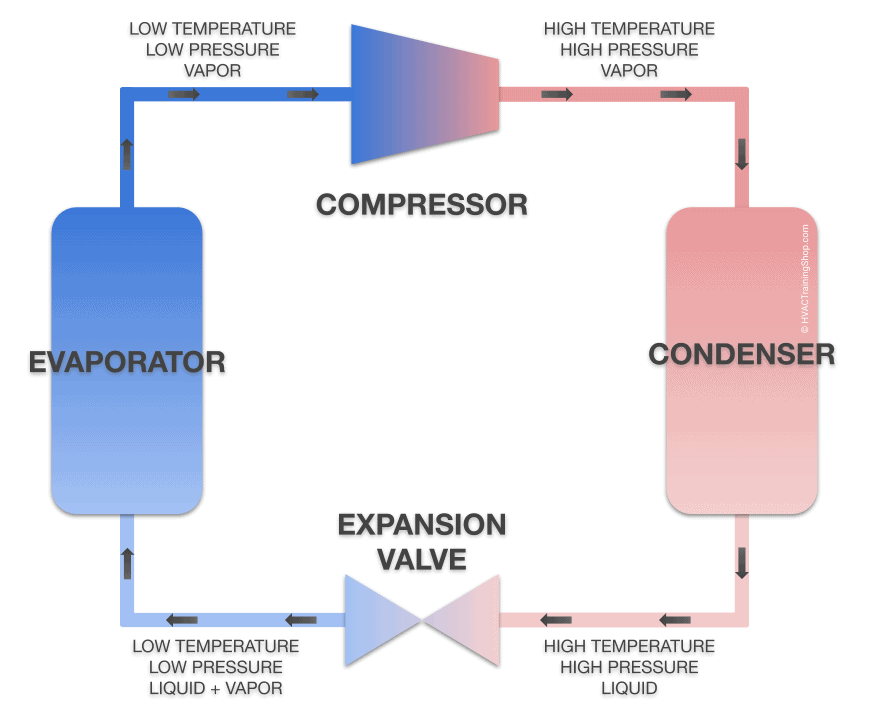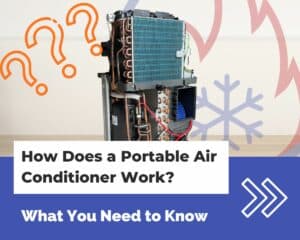HVAC Training Shop is reader-supported. As an Amazon Associate, I earn from qualifying purchases.
If you have just purchased a portable air conditioner, you may be surprised to find that it comes with an exhaust hose.
With all the trouble that comes with setting up an exhaust vent, you might ask yourself: Can I run my portable AC without an exhaust hose?
To answer that question, I’ll need to explain how a portable air conditioner works, and why the exhaust hose is necessary for your AC to function.
Can you run a portable AC without an exhaust hose?
If you need to cool your room, then you cannot use a portable air conditioner without an exhaust hose.
Portable air conditioners work by removing warm air from the inside of your room.
But the heat that it removes from your room needs to be put somewhere. This is where the exhaust hose comes into play.
As your portable AC removes heat from the air inside your room, it blows this heat out through the exhaust hose.
What happens if you don’t vent a portable air conditioner
If you don’t use the exhaust hose, then your portable AC will not cool your room. It will blow all the heat right back into your room.
By removing the vent hose and running your portable AC, you can turn your portable AC into a dehumidifier. If you use your portable AC in this manner it will dehumidify, but not cool your room.
How to vent a portable air conditioner without a window
Many people shy away from portable air conditioners because they don’t have a window to vent them out of. But there are other ways to vent your portable air conditioner, even if your room doesn’t have a window.
One way to vent your portable air conditioner is through a door. There are vent kits that are made specifically for venting a portable air conditioner out of a doorway.
If your door is a sliding door, you won’t have much trouble venting your air conditioner. But if you have a regular door that swings on its side, then there are solutions for that too.
Using a door vent kit, you can direct your exhaust hose to the outside while you leave your door cracked open.
Ventless portable air conditioners
If you absolutely need to cool your room without using a vent hose, then a ventless portable air conditioner is one option. Ventless air conditioners are also known as “swamp coolers”.
A swamp cooler works much differently than a normal air conditioner. Instead of moving heat from your indoor air to the outside, a swamp cooler works by trapping heat by converting water from a liquid into vapor.
If you’re confused about how a swamp cooler works, the principle is like sweating. As water evaporates from a swamp cooler, it absorbs heat from your room’s air.
The main drawback of swamp coolers is that they can make your room excessively muggy. This is the effect of humidifying your room to cool it.
For this reason, swamp coolers perform poorly in humid areas. If you live in a warm, tropical climate, then a swamp cooler will barely work at all.
As a rule of thumb, the dryer the air, the better a swamp cooler will perform. In fact, swamp coolers are actually a preferred method of cooling in hot, dry climates. In addition to cooling the air, a swamp cooler will also humidify the air.
How a portable air conditioner works
To understand why an exhaust hose is important, you need to know how a portable air conditioner works.
A portable air conditioner works by removing heat from a space by means of a refrigeration cycle.
What is the refrigeration cycle?
The refrigeration cycle allows your air conditioner to capture heat and move it to a different place.
The refrigeration cycle works by using a liquid-vapor refrigerant to move heat from one place to another:
- As a liquid-vapor mixture, the refrigerant absorbs heat through an evaporator coil. As heat is absorbed in the evaporator, the refrigerant transforms into a vapor.
- After the evaporator, the refrigerant vapor flows into a compressor. In the compressor, the refrigerant is compressed into hot vapor.
- As a hot vapor, the refrigerant flows into a condenser. In the condenser, the refrigerant vapor loses its heat and condenses into a liquid.
- After the condenser, the liquid refrigerant flows into an expansion valve. In the expansion valve, the liquid refrigerant loses pressure and expands into a liquid-vapor mixture.
- Finally, the liquid-vapor mixture flows back into the evaporator coil, and the cycle repeats.

Using the refrigeration cycle, the air conditioner facilitates heat transfer from one area to another. The evaporator will absorb heat from inside your home, and the condenser will put that heat outside.
The first law of thermodynamics states that energy cannot be created or destroyed, it can only change forms.
The implication here is that the heat that your air conditioner removes from your room cannot be destroyed, it can only be moved somewhere else. This is why you need to direct the exhaust vent outside.



